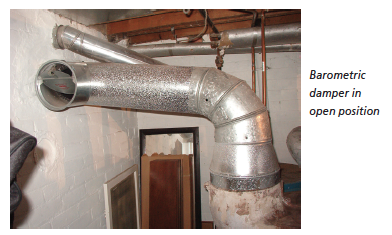

This controls how much the draft regulator door opens to let in air. To make adjustments, move the weights along the scale to the required level. Always pay attention to carbon dioxide readings as they show how complete the combustion process takes place. These include draft over the fire, draft in breech and carbon dioxide measurements.

Three sets of adjustments are made to control the device. Check these readings so as to make correct or very precise estimates when making adjustments. There is a standard number provided by manufacturers when the burner is operating at normal temperature. Normally, these should be adjusted according to manufacturer burner’s instruction. The stops found in double-acting dampers should be removed if firing only with gas.On the surface of the device, locate the weights and scale. Single-acting is traditionally used for oil-fired burners and double-acting is used for gas burners. In some locations, installation of spill switches is part of the boiler code.Įach fuel or combination of fuels requires a specific type of barometric damper. If spillage from the barometric damper gets into the boiler room, this switch will sense it and shut off the burner.

It is why I like seeing spill switches on the barometric damper. The double-acting damper actually will allow spillage of the flue gases into the boiler room in the event of blocked flues or downdrafts. The single-acting damper will close if pressure exists inside the stack. A double-acting damper allows the damper to swing two ways. A single-acting damper has a stop that only allows the damper to swing one way. When choosing a barometric damper, you will find two types: single- and double-acting. Boilers with pressurized vents would spill flue gases out of the barometric dampers into the room. If the gas pressure regulator is set for a certain pressure, the high draft can actually pull more gas through the regulator, overfiring the boiler.īarometric dampers are installed only on boilers with negative venting. Excessive draft also can cause the burner to overfire. This caused wet steam and tripping of the low-water cutoff. It caused violent surges and waves inside the boiler. We had a vertical fire-tube steam boiler where the flame was drawn into the rear tubes of the boiler. Flame impingement means the burner flame is touching the metal surfaces of the boiler that were not designed to have flame directly on them. It is similar to what happens when you keep bending a paper clip. Embrittlement is the loss of ductility of the metal. This could develop higher than desired levels of carbon monoxide.įlame impingement also could cause embrittlement of the boiler metal, lowering the life of the boiler. In addition to increased operating costs, the high draft can cause flame impingement on the boiler. Excessive draft inside a boiler can cause other strange behaviors. If the draft inside the chimney is greater than the setpoint, the damper will open and allow air from the boiler room inside the chimney, rather than stealing heat from the boiler.ĭraft controls are typically used when the stack or chimney height is greater than 30 ft. It is set for the desired draft conditions using weights and adjustment screws. The barometric damper is installed in the flue between the boiler and the chimney. High draft will pull the flue gases too quickly through a boiler, not allowing the heat to be transferred into the boiler. How do you provide a buffer to handle these erratic swings?Ī barometric damper is a great solution. The draft conditions inside the chimney could cause swings of 10, 20 or even 100 times that amount. The boiler requires a stable environment and the chimney is like the “wild child.” Most older boilers were designed to have a draft at the outlet of the boiler to be about -0.05 in. When a tall chimney is attached to a boiler, the draft readings will vary greatly.

ADJUSTING BAROMETRIC DRAFT CONTROL FREE
On another building, the engineer factored the building draft into his HVAC design and made a system using the chimney effect to provide free ventilation to the building without fans.


 0 kommentar(er)
0 kommentar(er)
